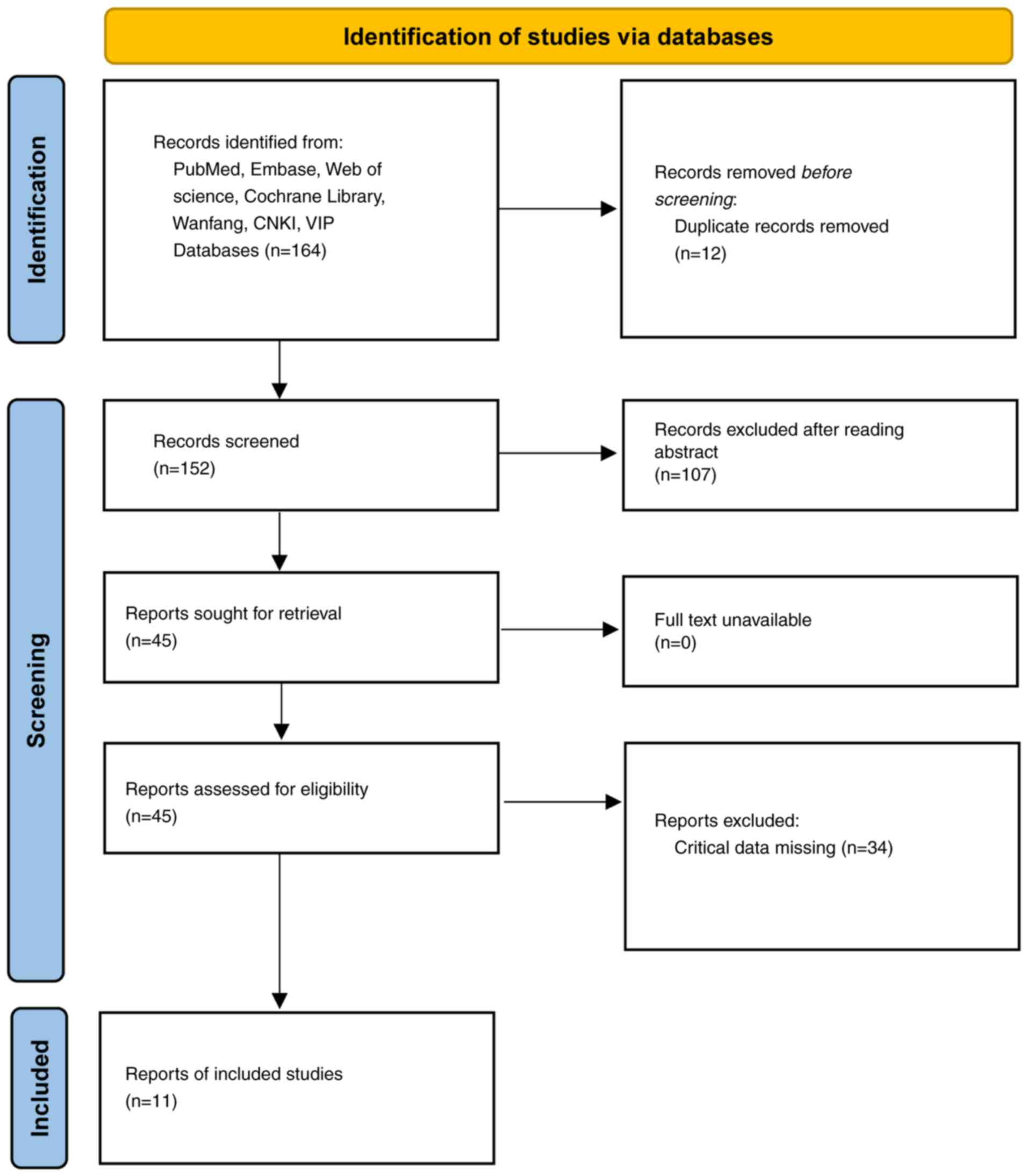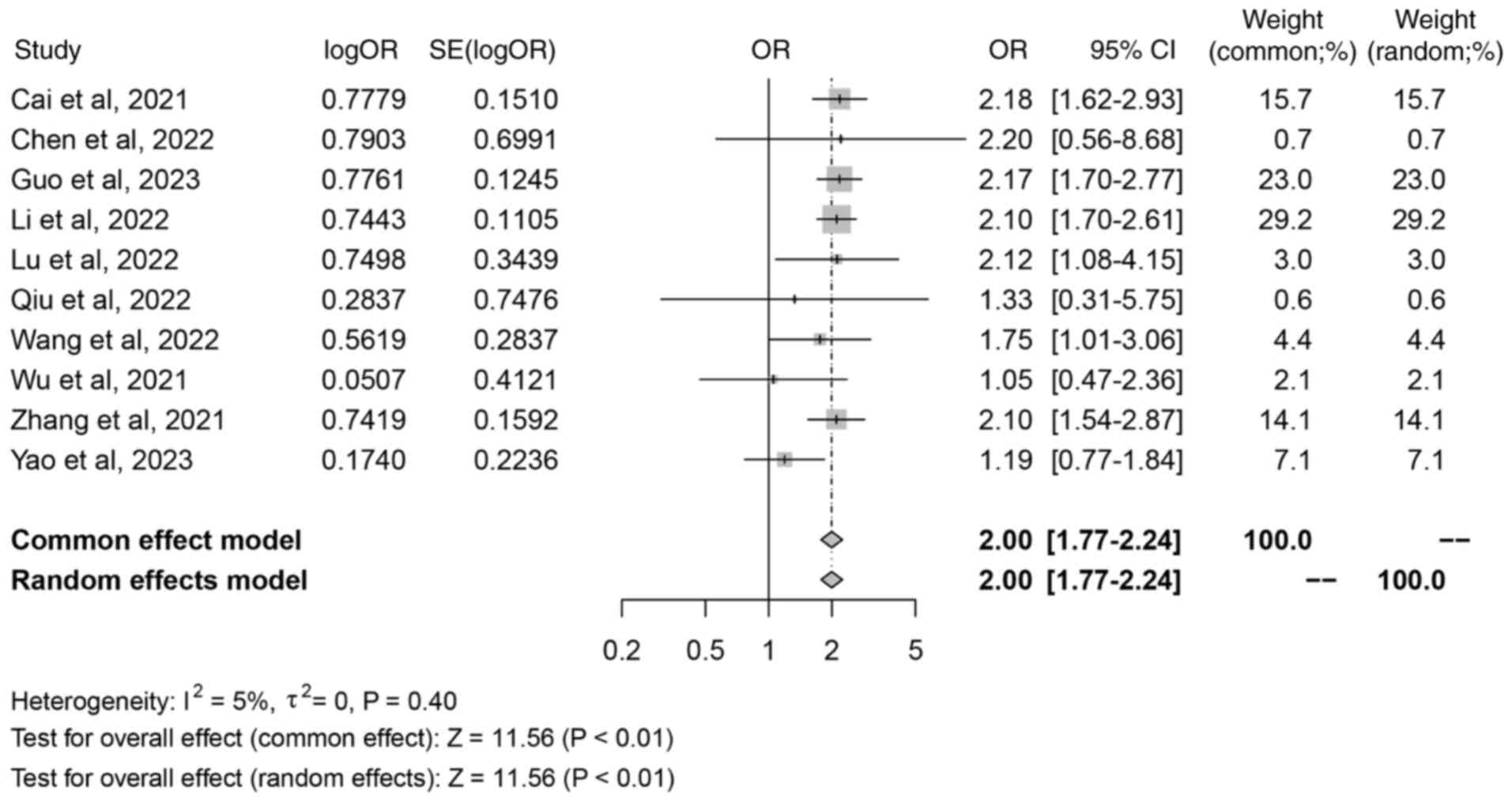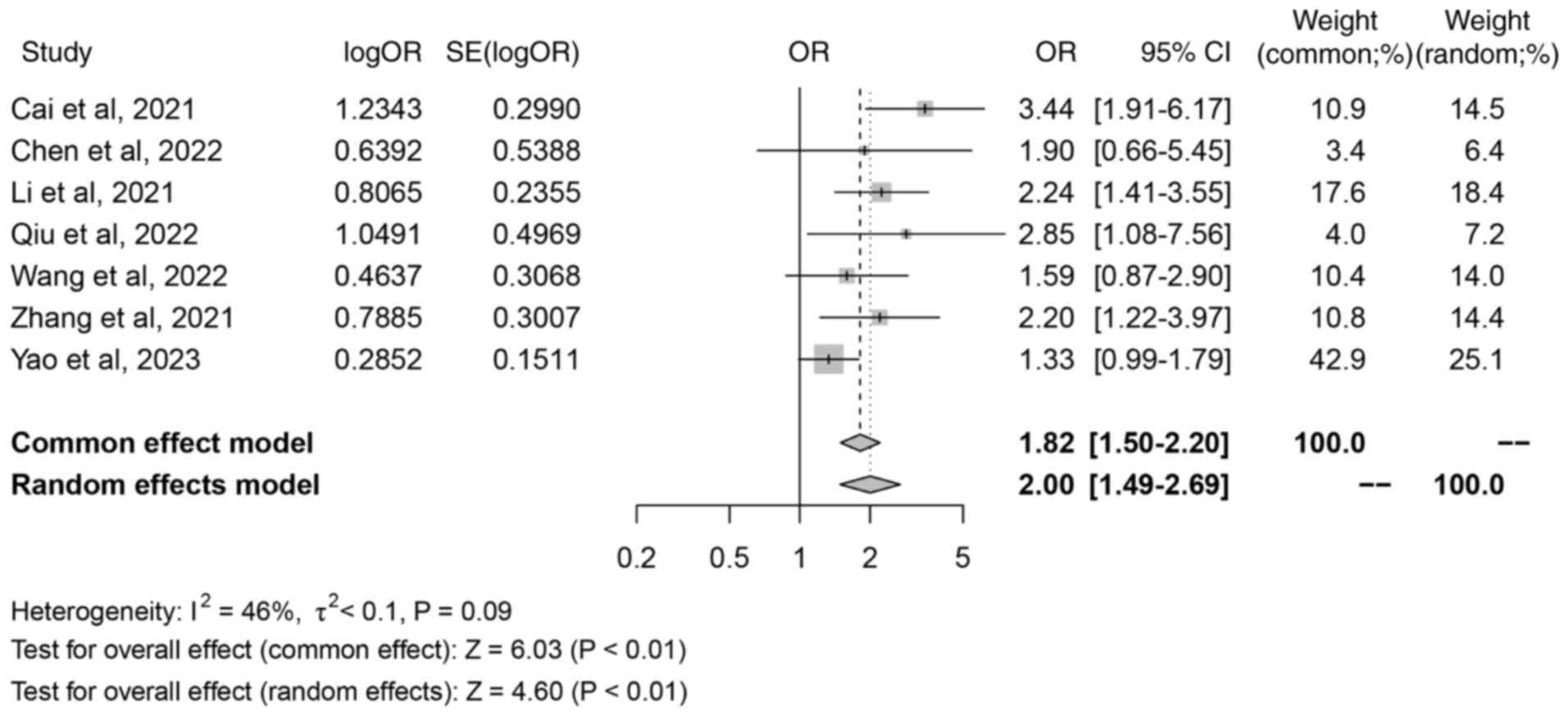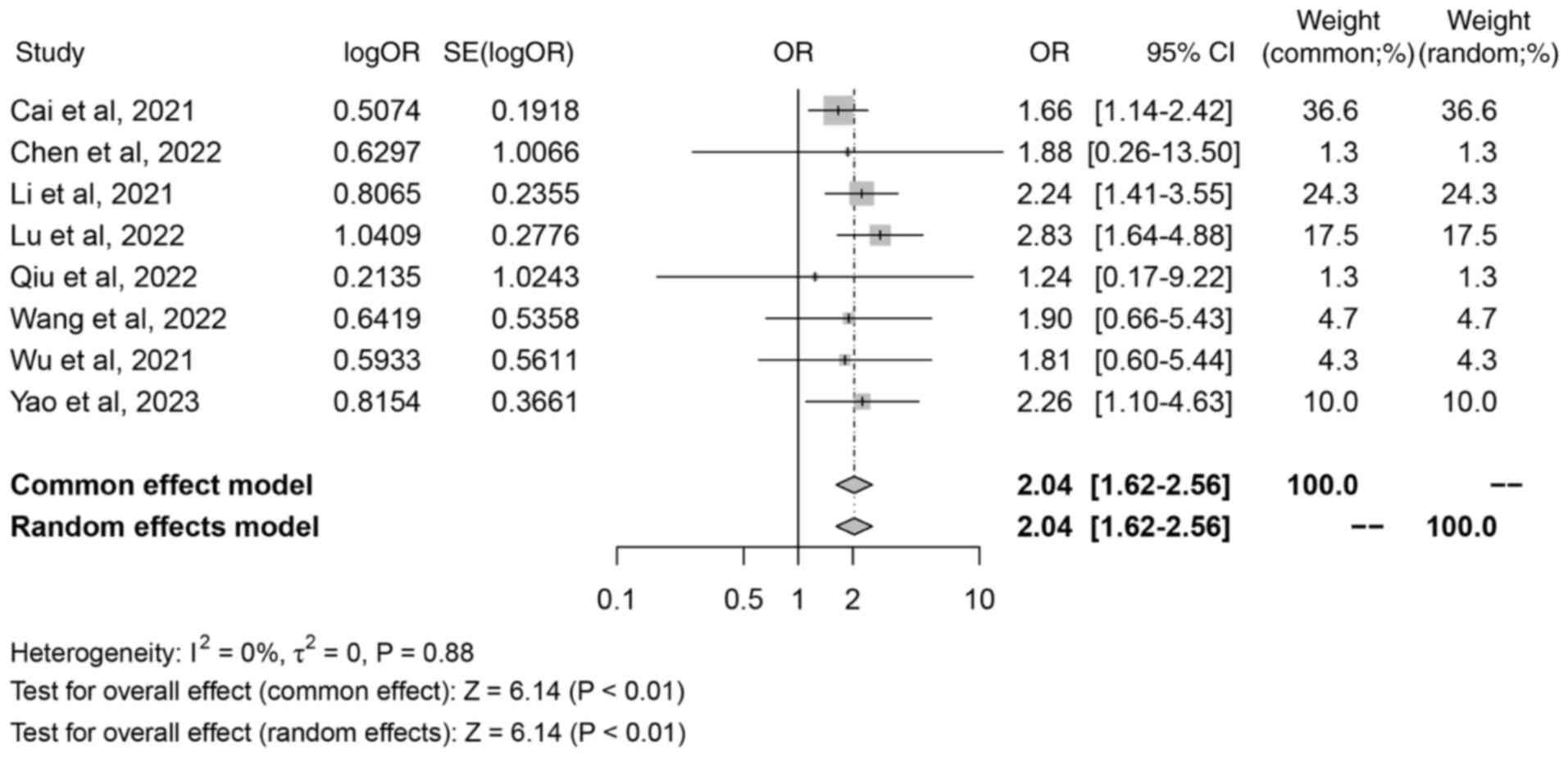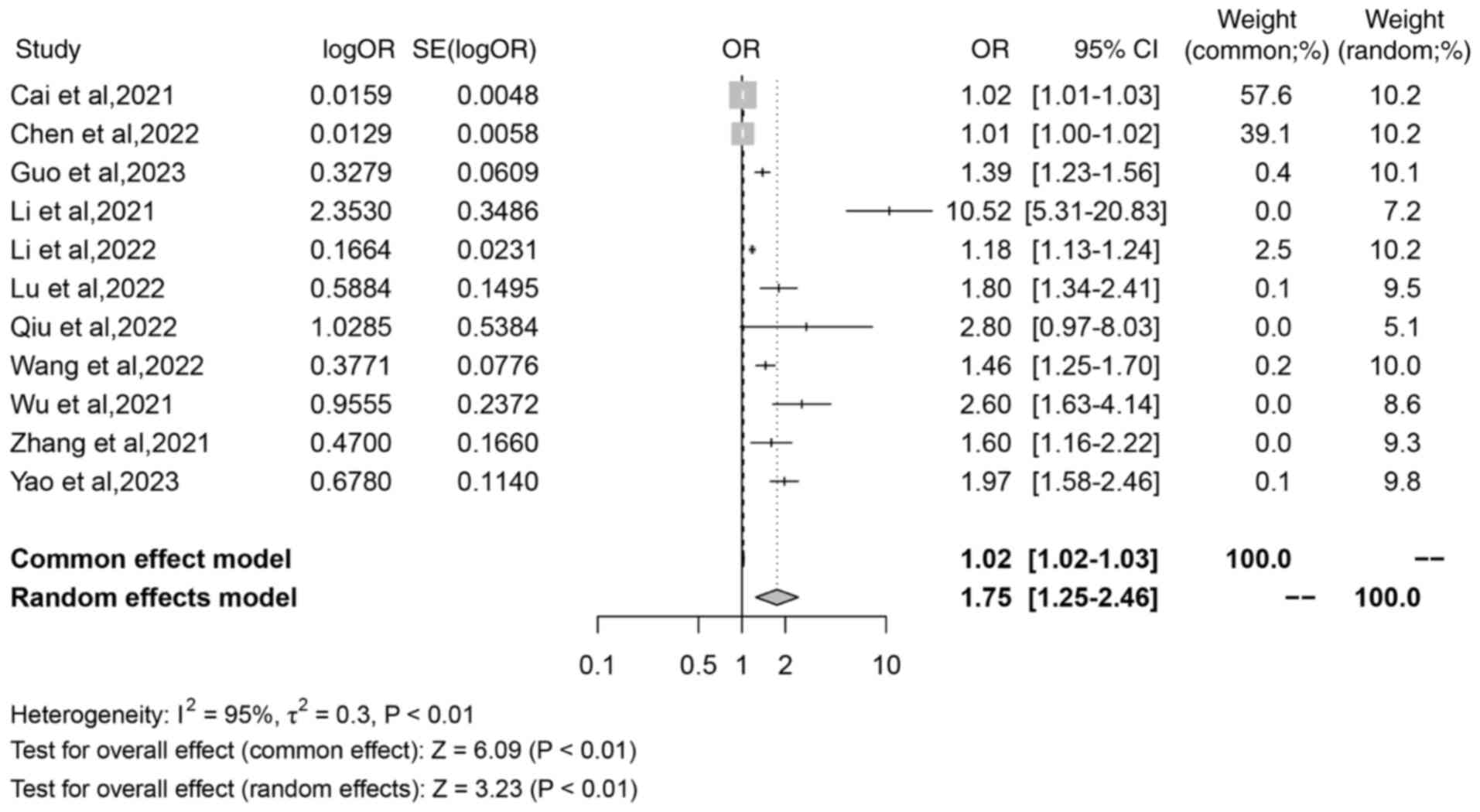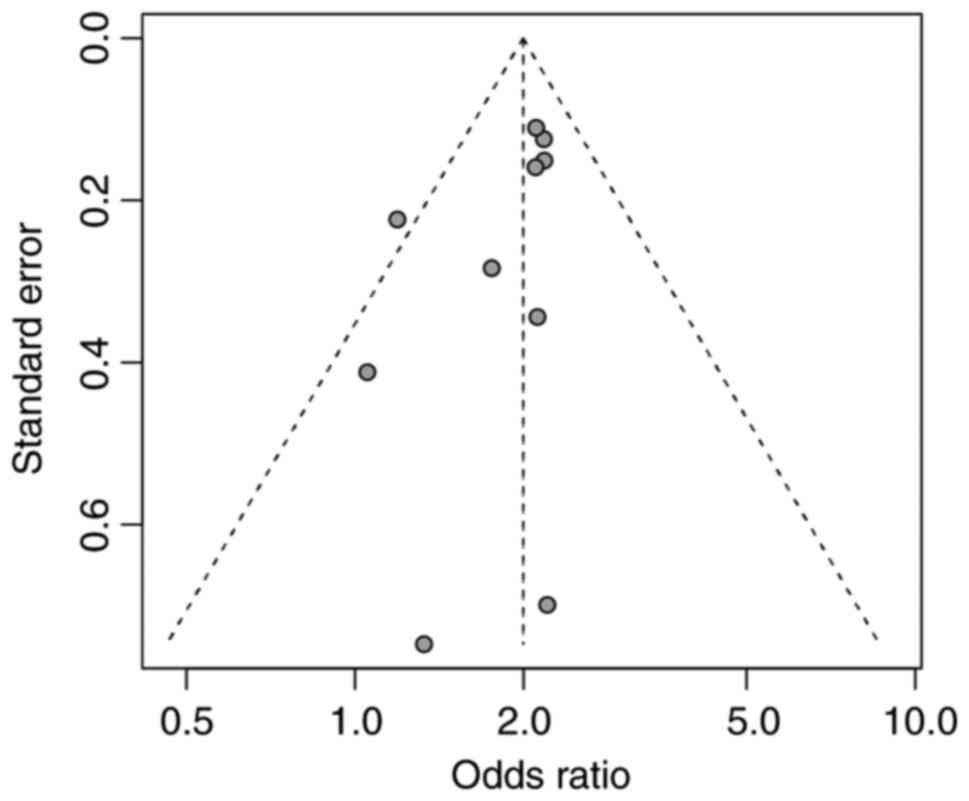Exploring the prognostic significance of iron death‑related lncRNAs in colorectal cancer: A systematic review and meta‑analysis
- Authors:
- Published online on: April 26, 2024 https://doi.org/10.3892/ol.2024.14417
- Article Number: 284
-
Copyright: © Hang et al. This is an open access article distributed under the terms of Creative Commons Attribution License.
Abstract
Introduction
Colorectal cancer, is a common malignant tumour worldwide, with >1 million new cases each year, accounting for ~10% of new cancer cases, and a mortality rate accounting for 9.4% of all cancer deaths, making it a focus of attention in the field of public health (1,2). Despite considerable progress in multimodal treatment approaches, including precision surgery and tailored chemoradiotherapy, achieving long-term survival and effective disease management poses significant challenges for patients with advanced or highly invasive forms of this cancer (3). Recent advancements in medical technology and the implementation of screening programs have improved the early diagnosis and treatment outcomes of colorectal cancer. Nonetheless, its prognosis is still determined by a complex interplay of tumor biology and molecular biomarkers (4–6).
The surge in molecular biology, transcriptomics and genomics research has spotlighted the pivotal role of long non-coding (lnc)RNAs in cancer development, growth and metastasis (7). lncRNAs are more complex than small RNAs and involve multiple regulatory mechanisms, including gene silencing, chromosomal alterations and protein translation regulation (8,9). Specifically, ferroptosis-related lncRNAs have emerged as key players in the pathogenesis if colorectal cancer (10–12). Ferroptosis, identified as a unique form of non-apoptotic and non-necrotic cell death, is considered a potential therapeutic target in several malignancies (13). The aberrant expression and dysfunction of iron death-related lncRNAs have been associated with prognosis, tumor progression and metastasis in colorectal cancer, suggesting their potential as novel biomarkers and therapeutic targets (14–16). Evidence has shown that iron death-related lncRNAs have specific expression patterns in colorectal cancer tissue and are closely associated with disease progression and prognosis (11,12). However, despite the increasing volume of research, the exact molecular mechanisms, biological functions and associations with clinical features of iron death-related lncRNAs in colorectal cancer are still controversial (10–20).
Therefore, the present study aimed to perform an exhaustive meta-analysis through systematic integration and analysis of existing literature to evaluate the expression differences of iron death-related lncRNAs in colorectal cancer tissues and further clarify their relationship with clinical prognosis. Through this comprehensive analysis, the study aimed to solidify the scientific foundation for considering iron death-related lncRNAs as viable prognostic biomarkers in colorectal cancer and to offer insightful recommendations for future investigations and clinical practices within this burgeoning domain.
Materials and methods
Search strategy
To thoroughly assess studies on the expression of ferroptosis-related lncRNAs in colorectal cancer tissues and their prognostic significance, the present study performed a systematic search across several databases, including PubMed (https://pubmed.ncbi.nlm.nih.gov/), Web of Science (https://www.webofscience.com/), Embase (https://www.embase.com/), Cochrane Library (https://www.cochranelibrary.com/), CNKI (https://www.cnki.net/), Wanfang (https://www.wanfangdata.com.cn/) and VIP (http://www.cqvip.com/) databases. The retrieval time was limited from the establishment of each database to October 2023. The search strategy used a combination of keywords and phrases such as ‘ferroptosis’ OR ‘iron death’ AND ‘LncRNA’ OR ‘long non-coding RNA’ AND ‘colorectal cancer’ OR ‘colon cancer’ AND ‘prognosis’. To ensure the search was exhaustive, the reference lists of relevant articles were also reviewed to ensure important studies were not missed. The search strategy was as follows: (‘Iron death’ OR ‘Ferroptosis’) AND (‘LncRNA’ OR ‘Long non-coding RNA’) AND (‘Colorectal cancer’ OR ‘Colon cancer’) AND (‘Prognosis’). Furthermore, the references of pertinent articles were also manually reviewed to identify any studies that were potentially overlooked. The detailed search methodology of the present study was aligned with the Preferred Reporting Items for Systematic Reviews and Meta-Analyses checklist, with the aim to guarantee the thoroughness and precision of the search.
Inclusion and exclusion criteria
The inclusion criteria were as follows: i) Research studies on patients with colorectal cancer, specifically reporting on the expression levels of ferroptosis-related lncRNAs within colorectal cancer tissues; and ii) studies providing relevant data on the association between lncRNA expression and prognosis in patients with colorectal cancer, such as survival rates and recurrence rates, with ≥2 outcome metrics.
The exclusion criteria were as follows: i) Studies that were not relevant to the topic or did not include the expression and prognosis of iron death-related lncRNAs in colorectal cancer; ii) studies with incomplete data, duplicate publications, or those only in abstract form; and iii) review articles, overviews, case reports, conference abstracts and other non-original research publications.
Data extraction
The following key information was methodically extracted: First author, publication year, sample size, patient demographics (male/female ratio), follow-up outcomes, and prognostic markers (tumor stage, T stage, lymph node metastasis, distant metastasis and risk score). Statistical outcomes, such as hazard ratios (HRs) and 95% confidence intervals (CIs) were also extracted. This process was performed independently by two researchers to ensure accuracy, with any discrepancies resolved through consultation with a third researcher.
Literature quality evaluation
The quality of the included literature was assessed using the Newcastle-Ottawa Scale (NOS) (21), a tool for evaluating observational studies, especially cohort and case-control studies, by scoring ≤9 points based on three dimensions, namely selection criteria, comparability and outcome measures. Studies scoring ≥7 were deemed high-quality; scores of 4–6 indicated moderate quality; and scores of ≤3 were considered low-quality.
Statistical analysis
In the present meta-analysis, R software version 4.3.1 (The R Foundation) was used to statistically analyze the collated data. The association between iron death-related lncRNAs and prognosis in colorectal cancer were quantitatively evaluated using HRs and 95% CIs. The I2 test and Q test were used to assess heterogeneity among studies in the meta-analysis. Heterogeneity between studies was not considered significant when I2<50% or P>0.05, and conversely, significant heterogeneity was considered to exist. As the studies included in the present study are from different groups and geographical locations and may be subject to heterogeneity, the results of the meta-analyses were thus interpreted using a random-effects model to accommodate the inherent heterogeneity between the different studies. Publication bias was evaluated through funnel plot analyses, Begg's and Egger's test. Sensitivity analysis was performed to assess the robustness and reliability of the findings. All statistical tests were two-sided, and P<0.05 was considered to indicate a statistically significance difference.
Results
Literature screening and characteristics
Following the outlined search strategy, 164 relevant articles were initially retrieved, from which 152 were selected for preliminary screening after removing duplicates. After the screening of titles and abstracts, 107 articles were excluded due to obvious irrelevance to the topic. The remaining 45 articles were then read in full, and 34 articles were further excluded due to missing key data. Finally, 11 articles were included in the meta-analysis (Fig. 1). The included literature mainly dealt with the expression levels of iron death-related lncRNAs and their association with prognosis in patients with colorectal cancer. The main characteristics of the included studies are presented in Table I. The results of risk-of-bias assessments of the included literature demonstrated that all the included studies had NOS scores ≥6, which met the quality requirements of the present paper (Table II).
Meta-analysis results
Tumor stage classificationA total of 10 studies were included in the analysis, all of which assessed the association between iron death-related lncRNAs and tumor stage classification. There were 5 main outcome measures in the present study, and if there were >2 outcome measures included in the literature, the study met the criteria of the present study. Therefore, certain outcome measures did not include all included in the literature, so <11 studies were included in this result. The meta-analysis demonstrated a no significant heterogeneity (I2=5%; P=0.40) and was analyzed using a fixed-effects model. The random effects model analysis revealed a combined odds ratio (OR) of 2.00 (95% CI, 1.77–2.24; Z=11.56; P<0.01; Fig. 2), indicating a significant association between ferroptosis-related lncRNAs and tumor stage prediction.
T stage
A total of 7 studies were included in the analysis of the relationship between iron death-related lncRNAs and the T stage. There were 5 main outcome measures in the present study, and if there were >2 outcome measures included in the literature, the study met the criteria of the present study. Therefore, certain outcome measures did not include all included in the literature, so <11 studies were included in this result. The meta-analysis of the combined results showed that the included literature presented moderate, but not significant, heterogeneity (I2=46%, P=0.09), and a fixed-effect model was used for analysis. The random effects model analysis demonstrated a combined OR of 2.00 (95% CI, 1.49–2.69;, Z=4.60; P<0.01; Fig. 3), which indicated that there was a significant association between iron death-related lncRNAs and T stage.
Lymphatic metastasis of colorectal cancer
A total of 8 studies reported the association between iron death-related lncRNAs and lymphatic metastasis of colorectal cancer. There were 5 main outcome measures in the present study, and if there were >2 outcome measures included in the literature, the study met the criteria of the present study. Therefore, certain outcome measures did not include all included in the literature, so <11 studies were included in this result. The meta-analysis showed moderate heterogeneity in the included literature (I2=50%; P=0.05), which was analyzed by a random effect model. The random effects model analysis revealed the combined OR was 1.31 (95% CI, 1.03–1.66; Z=2.16; P=0.03; Fig. 4), which indicated that there was a significant association between iron death-related lncRNAs and lymph node metastasis of colorectal cancer.
Distant metastasis of colorectal cancer
A total of 8 studies reported the association between iron death-related lncRNAs and distant metastasis. There were 5 main outcome measures in the present study, and if there were >2 outcome measures included in the literature, the study met the criteria of the present study. Therefore, certain outcome measures did not include all included in the literature, so <11 studies were included in this result. The meta-analysis revealed no significant heterogeneity (I2=0%; P=0.88). The random effects model was selected to interpret the results regardless of heterogeneity, and the results were consistent between the random and fixed effects models. The random effects model analysis demonstrated a combined OR of 2.04 (95% CI, 1.62–2.56; Z=6.14; P<0.01; Fig. 5), which indicated that there was a significant association between iron death-related lncRNAs and distant metastasis of colorectal cancer.
Colorectal cancer risk score
A total of 11 studies reported the association between iron death-related lncRNAs and distant metastasis. The meta-analysis revealed significant and considerable heterogeneity (I2=95%; P<0.01), which was assessed using a random effect model. The random effects model analysis demonstrated a combined OR of 1.75 (95% CI, 1.25–2.46; Z=3.23; P<0.01; Fig. 6), which indicated that there was a significant association between iron death-related lncRNAs and colorectal cancer risk score.
Publication bias
To assess the possible publication bias that may exist in the research, Begg's and Egger's tests were performed. The funnel plot results demonstrated that although there was one study outside the funnel, there was good symmetry of the funnel plot (Fig. 7) The results of Begg's test (z=−2.06; P=0.04) and Egger's test (t=−1.71; P=0.12) indicate a degree of publication bias among the studies included.
Sensitivity analysis
A sensitivity analysis, excluding each study systematically, affirmed the stability and reliability of the results of the meta-analyses. The direction and significance of the overall effect remained unchanged irrespective of the study removed, indicating robustness in the findings (data not shown).
Discussion
With the rapid development of molecular biology and transcriptomics technologies, lncRNAs have become a new focus in cancer research (22–24). In colorectal cancer, lncRNAs not only serve a role in cancer cell proliferation, metastasis and invasion, but they are also associated with patient prognosis (25). The present meta-analysis assessed iron death-related lncRNAs within colorectal cancer, shedding light on their potential clinical utility.
The results of the present study demonstrated a significant association between the overexpression of iron death-related lncRNAs and several clinical characteristics of colorectal cancer, such as tumor stage, T stage, lymph node metastasis, distant metastasis and risk scoring. These findings highlight the central role of lncRNAs in the progression of colorectal cancer and support the viewpoint that they serve as important biomarkers. Particularly, given the paramount importance of lymph node and distant metastases in prognostic evaluations, the expression levels of iron death-related lncRNAs emerge as potent predictors for these conditions (11,12).
Furthermore, although the present meta-analysis results demonstrated a significant association between iron death-related lncRNAs and colorectal cancer prognosis, the specific biological mechanisms involved remain unclear. It is possible that they influence the growth and metastasis of colorectal cancer by regulating certain key genes or signaling pathways (26,27). Future experimental studies should investigate their mechanisms of action, which will provide insights into the development of novel therapeutic strategies for colorectal cancer. Moreover, it is worth noting that although the present study found a degree of publication bias in the review, the overall quality of these trials was acceptable. In addition, the present study assessed the stability of the meta-analysis results through sensitivity analysis, further strengthening the conclusions. Finally, multiple lncRNAs associated with iron death were included, such as lncRNA associated with poor prognosis of hepatocellular carcinoma (AWPPH), AC004687.1, AC010973.2, AP001189.3, LINC01503, NCK1 Divergent Transcript (NCK1−DT), GFL2-AS1, LOXL1 antisense RNA 1 (LOXL1-AS1), Taurine Upregulated Gene 1 (TUG1) and the XIRP2-AS1 MIR31 Host Gene (MIR31HG), all of which are upregulated lncRNAs. However, subgroup analyses of lncRNAs were not performed, as the amount of data available in the literature was limited, as was the analysis of the prognostic impact of different types of lncRNAs on colon cancer.
In conclusion, the present meta-analysis demonstrates the role of iron death-related lncRNAs as innovative prognostic biomarkers in colorectal cancer. Nevertheless, there is a need for further prospective studies and mechanistic explorations to corroborate the findings of the present study and pioneer new diagnostic and therapeutic strategies for this malignancy.
Acknowledgements
Not applicable.
Funding
Funding: No funding was received.
Availability of data and materials
The data generated in the present study may be requested from the corresponding author.
Authors' contributions
XLH and JS made substantial contributions in conceiving and drafting the manuscript. XLH and ZXD made substantial contributions to acquisition of data. XLH and JS made substantial contributions to the analysis and interpretation of data. XLH and JS confirm the authenticity of all the raw data. All authors have read and approved the final manuscript.
Ethics approval and consent to participate
Not applicable.
Patient consent for publication
Not applicable.
Competing interests
The authors declare that they have no competing interests.
References
|
Xu J, Zeng W, Liu T, Wan Z, Yang X, Chen J and Liu F: lncRNA TINCR knockdown inhibits colon cancer cells via regulation of autophagy. Food Sci Nutr. 11:1965–1981. 2023. View Article : Google Scholar : PubMed/NCBI | |
|
Yu Y, Xu Z, Ni H, Jin M and Dai C: Clinicopathological and prognostic value of long non-coding RNA CCAT1 expression in patients with digestive system cancer. Oncol Lett. 25:732023. View Article : Google Scholar : PubMed/NCBI | |
|
Qu A, Wang Q, Chang Q, Liu J, Yang Y, Zhang X and Zhang Y, Zhang X, Wang H and Zhang Y: Prognostic and predictive value of a lncRNA signature in patients with stage II colon cancer. Sci Rep. 13:13502023. View Article : Google Scholar : PubMed/NCBI | |
|
Liang GZ, Wen XF, Song YW, Zhang ZJ, Chen J, Chen YL, Pan WD, He XW, Hu T and Xian ZY: Construction and validation of a novel prognosis model in colon cancer based on cuproptosis-related long non-coding RNAs. J Clin Med. 12:15282023. View Article : Google Scholar : PubMed/NCBI | |
|
Liau XL, Salvamani S, Gunasekaran B, Chellappan DK, Rhodes A, Ulaganathan V and Tiong YL: CCAT 1-a pivotal oncogenic long non-coding RNA in colorectal cancer. Br J Biomed Sci. 80:111032023. View Article : Google Scholar : PubMed/NCBI | |
|
Liu S, Zhang S, Liu Y, Yang X and Zheng G: Comprehensive analysis of cuproptosis-related long noncoding RNA for predicting prognostic and diagnostic value and immune landscape in colorectal adenocarcinoma. Hum Genomics. 17:222023. View Article : Google Scholar : PubMed/NCBI | |
|
Sepehri Z, Banerjee A, Vizeacoumar FS, Freywald A, Vizeacoumar FJ, Dolinsky VW and Davie JR: Differential expression of HNF1A and HNF1A-AS1 in colon cancer cells. IUBMB Life. 74:496–507. 2022. View Article : Google Scholar : PubMed/NCBI | |
|
Luo J, Peng J, Xiao W, Huang S, Cao Y, Wang T and Wang X: A novel necroptosis-related lncRNA signature for predicting prognosis and immune response of colon cancer. Front Genet. 13:9846962022. View Article : Google Scholar : PubMed/NCBI | |
|
Luo Y, Huang S, Wei J, Zhou H, Wang W, Yang J, Deng Q, Wang H and Fu Z: Long noncoding RNA LINC01606 protects colon cancer cells from ferroptotic cell death and promotes stemness by SCD1-Wnt/β-catenin-TFE3 feedback loop signalling. Clin Transl Med. 12:e7522022. View Article : Google Scholar : PubMed/NCBI | |
|
Li H, Liu L, Huang T, Jin M, Zheng Z, Zhang H, Ye M and Liu K: Establishment of a novel ferroptosis-related lncRNA pair prognostic model in colon adenocarcinoma. Aging (Albany NY). 13:23072–23095. 2021. View Article : Google Scholar : PubMed/NCBI | |
|
Wu Z, Lu Z, Li L, Ma M, Long F, Wu R, Huang L, Chou J, Yang K, Zhang Y, et al: Identification and validation of ferroptosis-related LncRNA signatures as a novel prognostic model for colon cancer. Front Immunol. 12:7833622021. View Article : Google Scholar : PubMed/NCBI | |
|
Zhang W, Fang D, Li S, Bao X, Jiang L and Sun X: Construction and validation of a novel ferroptosis-related lncRNA signature to predict prognosis in colorectal cancer patients. Front Genet. 12:7093292021. View Article : Google Scholar : PubMed/NCBI | |
|
Cai HJ, Zhuang ZC, Wu Y, Zhang YY, Liu X, Zhuang JF, Yang YF, Gao Y, Chen B and Guan GX: Development and validation of a ferroptosis-related lncRNAs prognosis signature in colon cancer. Bosn J Basic Med Sci. 21:569–576. 2021.PubMed/NCBI | |
|
Li N, Shen J, Qiao X, Gao Y, Su HB and Zhang S: Long non-coding RNA signatures associated with ferroptosis predict prognosis in colorectal cancer. Int J Gen Med. 15:33–43. 2022. View Article : Google Scholar : PubMed/NCBI | |
|
Lu J, Tan J and Yu X: A prognostic ferroptosis-related lncRNA model associated with immune infiltration in colon cancer. Front Genet. 13:9341962022. View Article : Google Scholar : PubMed/NCBI | |
|
Qiu Y, Li H, Zhang Q, Qiao X and Wu J: Ferroptosis-related long noncoding RNAs as prognostic marker for colon adenocarcinoma. Appl Bionics Biomech. 2022:52203682022. View Article : Google Scholar : PubMed/NCBI | |
|
Chen W, Chen Y, Liu L, Wu Y, Fu P, Cao Y, Xiong J, Tu Y, Li Z, Liu Y and Jie Z: Comprehensive analysis of immune infiltrates of ferroptosis-related long noncoding RNA and prediction of colon cancer patient prognoses. J Immunol Res. 2022:94806282022. View Article : Google Scholar : PubMed/NCBI | |
|
Wang Y, Zhang Y, Xu W and Cui X: Construction and clinical application of colon cancer prognostic risk model of ferroptosis-related lncRNA. Laboratory Med. 37:720–728. 2022.(In Chinese). | |
|
Li Y, Huan S and Xiang L: Construction and validation of colorectal cancer prognosis risk model based on iron death-related lncRNA. Zhejiang J Clin Med J. 25:167–171. 2023.(In Chinese). | |
|
Guo S, Song B, Li L, Li H, Yang T, Cao L and Wang J: lncRNA HCG11 promotes colorectal cancer cell malignant behaviors via sponging mir-26b-5p. J Immunol Res. 2023:90112322023. View Article : Google Scholar : PubMed/NCBI | |
|
Stang A: Critical evaluation of the Newcastle-Ottawa scale for the assessment of the quality of nonrandomized studies in meta-analyses. Eur J Epidemiol. 25:603–605. 2010. View Article : Google Scholar : PubMed/NCBI | |
|
Hosseini FA, Rejali L, Zabihi MR, Salehi Z, Daskar-Abkenar E, Taraz T, Fatemi N, Hashemi M, Asadzadeh-Aghdaei H and Nazemalhosseini-Mojarad E: Long non-coding RNA LINC00460 contributes as a potential prognostic biomarker through its oncogenic role with ANXA2 in colorectal polyps. Mol Biol Rep. 50:4505–4515. 2023. View Article : Google Scholar : PubMed/NCBI | |
|
Zhao C, Gan C, Xiao Y, Liu R, Zhang L, Lan T, Ye Y, Tong H, Huang Z, Tang C and Gao J: High expression of long non-coding RNA Linc-A associates with poor survival in patients with colorectal cancer. Mol Biol Rep. 47:7497–7504. 2020. View Article : Google Scholar : PubMed/NCBI | |
|
Tsai KW, Lo YH, Liu H, Yeh CY, Chen YZ, Hsu CW, Chen WS and Wang JH: Linc00659, a long noncoding RNA, acts as novel oncogene in regulating cancer cell growth in colorectal cancer. Mol Cancer. 17:722018. View Article : Google Scholar : PubMed/NCBI | |
|
Gaballah HH, Gaber RA, Elrashidy MA, Elshahat DA, Hablus MA and Ebeid AM: Expression of long non-coding RNA CCHE1 in colorectal carcinoma: correlations with clinicopathological features and ERK/COX-2 pathway. Mol Biol Rep. 46:657–667. 2019. View Article : Google Scholar : PubMed/NCBI | |
|
Xiong Z, Li W, Luo X, Lin Y, Huang W and Zhang S: Seven bacterial response-related genes are biomarkers for colon cancer. BMC Bioinformatics. 24:1032023. View Article : Google Scholar : PubMed/NCBI | |
|
Shaalan AAM, Mokhtar SH, Ahmedah HT, Almars AI, Toraih EA, Ibrahiem AT, Fawzy MS and Salem MA: Prognostic value of LINC-ROR (rs1942347) variant in patients with colon cancer harboring BRAF mutation: A propensity score-matched analysis. Biomolecules. 12:5692022. View Article : Google Scholar : PubMed/NCBI |



